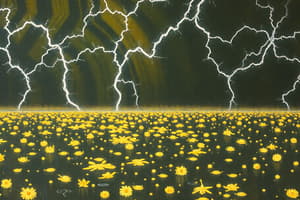Podcast
Questions and Answers
Which of the following correctly describes the relationship between abiotic and biotic factors in an ecosystem?
Which of the following correctly describes the relationship between abiotic and biotic factors in an ecosystem?
- Abiotic and biotic factors are interconnected, with biotic factors relying on abiotic factors for survival, and biotic factors influencing the abiotic environment. (correct)
- Abiotic factors are living organisms, while biotic factors are non-living components of the environment.
- Abiotic and biotic factors are independent of each other, existing in separate spheres within an ecosystem.
- Abiotic factors have a direct impact on biotic factors, while biotic factors have no influence on abiotic factors.
Which of the following correctly describes Ohm's Law?
Which of the following correctly describes Ohm's Law?
- The voltage across a conductor is directly proportional to the resistance of the conductor and inversely proportional to the current through it.
- The current through a conductor is directly proportional to the voltage applied across its ends and inversely proportional to the resistance of the conductor. (correct)
- Ohm's Law states that the power dissipated by a conductor is equal to the product of the voltage and the current.
- The resistance of a conductor is directly proportional to the current through it and inversely proportional to the voltage applied across its ends.
Which of the following is NOT a physical property of matter?
Which of the following is NOT a physical property of matter?
- Flammability (correct)
- Density
- Color
- Boiling Point
Which of the following is an example of a chemical change?
Which of the following is an example of a chemical change?
What is the primary difference between producers and consumers in an ecosystem?
What is the primary difference between producers and consumers in an ecosystem?
Flashcards
Physical Properties
Physical Properties
Properties that can be observed or measured without changing the substance's composition. For example, color, density, melting point, boiling point, and hardness.
Ecology
Ecology
The study of organisms and their interactions with each other and their environment.
Elements
Elements
The basic building blocks of matter, each with a unique atomic number and chemical properties. They are arranged in the periodic table according to their atomic number and similar properties.
States of Matter
States of Matter
Signup and view all the flashcards
Law of Electric Charges
Law of Electric Charges
Signup and view all the flashcards
Study Notes
Types of Charges
- Charges can be positive or negative.
- Like charges repel each other; unlike charges attract.
Law of Electric Charges
- Charges exert forces on each other.
- Coulombs' law describes this force between charges.
- Force is proportional to the product of the charges and inversely proportional to the square of the distance between them.
Producers and Consumers
- Producers create their own food (e.g., plants through photosynthesis).
- Consumers obtain energy by consuming other organisms.
Abiotic and Biotic Factors
- Abiotic factors are non-living components of an ecosystem (e.g., sunlight, water, temperature).
- Biotic factors are living components of an ecosystem (e.g., plants, animals, bacteria).
Physical Properties
- Physical properties describe the characteristics of a substance without changing its chemical composition (e.g., density, melting point, boiling point).
- These properties can be observed or measured.
Elements/Periodic Table
- Elements are pure substances made of one type of atom.
- The periodic table organizes elements by their atomic number and properties.
- Elements have specific atomic numbers and symbols.
Bohr-Rutherford Diagrams
- Visual representations of atom structure.
- Show the arrangement of protons, neutrons, and electrons.
- Electrons orbit the nucleus.
Ohm's Law
- Relates voltage, current, and resistance in an electrical circuit.
- Voltage = Current x Resistance (V=IR)
Population States
- Populations can increase, decrease, or remain stable in size.
- Factors influencing population size include birth rate, death rate, immigration, and emigration.
Definition of Ecology
- Ecology is the study of the relationships between organisms and their environment.
- It examines interactions between organisms and their surroundings
Change in Matter
- Matter can undergo physical or chemical changes.
- Physical changes alter the appearance of matter without changing its chemical composition.
- During chemical changes, new substances are formed with different properties than the original substances.
Studying That Suits You
Use AI to generate personalized quizzes and flashcards to suit your learning preferences.




